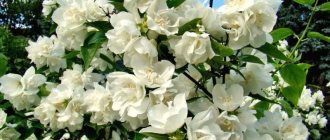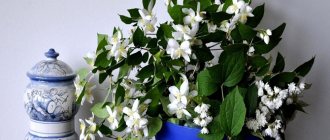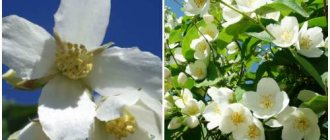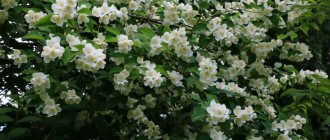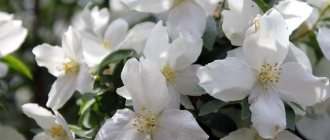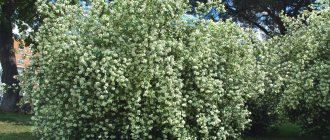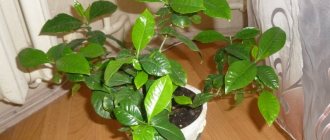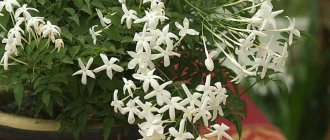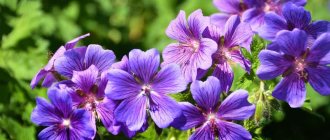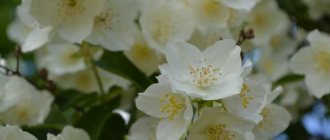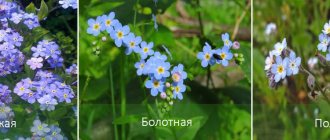We firmly associate the Jasmine flower with tea and aromatic garden shrubs (garden jasmine).
But, in fact, jasmine has nothing to do with the shrubs that grow in the gardens of central Russia. Mock orange grows in open ground, which is similar to jasmine only in the aroma of the flowers; otherwise, these are completely different plants belonging to different families. Real jasmine is an evergreen vine or shrub, which, due to its demanding and capricious nature, simply will not survive our winter and is grown here exclusively as a potted crop, which is the pride of any gardener.
Buy Jasmine seeds =>>
General description of culture
The culture includes more than 250 plant species. These can be climbing bushes or plants with straight stems. The shoots are thin, covered with unpaired leaves of rich green color. The inflorescences have the shape of lush umbrellas.
The color of the petals is varied: from cream to yellow. The plant is known for its unpretentiousness and rapid adaptation to changing environmental conditions. The benefits and harms of jasmine flowers are also very interesting, for which the plant has gained particular popularity.
Kinds
Multifloral jasmine (Jasminum polyanthum)
Jasmine genus (Jasminum) has 198 plant species and belongs to the Olive family (Oleaceae). These plants grow in tropical and subtropical regions of Asia, Africa, Australia, on the islands of the South Pacific Ocean, and one species each in the Mediterranean and South America.
The genus name is the Latinized Persian name of the plant.
These are trees, erect or climbing shrubs, evergreen or deciduous. Branches are cylindrical, angular or grooved. Leaves are opposite or alternate, rarely whorled, simple, trifoliate or odd-pinnate, usually on articulated petioles. The inflorescences are mostly racemose, paniculate, corymbose or umbellate, rarely solitary flowers. The flowers are bisexual and usually fragrant. The calyx is campanulate, cup-shaped or funnel-shaped, 4-16 lobed. The corolla is white or yellow, less often reddish or purple, funnel-shaped, with 4-16 lobes, imbricated over each other in the bud. The fruit is a berry.
Multi-flowered jasmine (Jasminum polyanthum) - grows in Western China in valleys and forests, at altitudes of 1400-3000 m above sea level.
Liana 1-10 m tall. The branches are angular, bare. The leaves are opposite, pinnately divided or pinnately compound, on petioles 0.4-2 cm long. The leaves are 5-7, ovate, 1.5-8.5 cm long and 1-2.7 cm wide, round or almost heart-shaped at the base, obtuse or sharp at the apex. Inflorescences are racemes or panicles terminal or axillary, 5-50 flowers. The flowers are white, reddish outside and in the bud, with 5 oblong or narrow ovate lobes 0.9-1.5 cm long. The aroma of the flowers is stronger than that of other species.
Jasmine sambac, or Arabian (Jasminum sambac) - originally from India, is widely cultivated throughout the world. Used to flavor tea.
Evergreen tropical liana up to 3 m tall. The branches are forked, slightly compressed, sometimes hollow, sparsely pubescent. Leaves are opposite, simple, on jointed petioles 2-6 mm long, from round to elliptical or obovate, 4-12.5 cm long and 2-7.5 cm wide, glabrous, except for tufts of hairs in the axils of the veins at the bottom of the leaf, on the ends are blunt, sometimes almost heart-shaped at the base. Inflorescences are terminal, umbellate, 1-, 3-, or 5-flowered. The flowers are very fragrant, white, with a tube 0.7-1.5 cm long and oblong or almost rounded limb lobes 5-9 cm long. Flowers can be single, semi-double or double.
| Jasmine sambac (Jasminum sambac) |
| Jasmine beesianum (Jasminum beesianum) |
Azorean jasmine (Jasminum azoricum) is native to the island of Madeira.
Evergreen liana up to 5-6 m tall. The leaves are trifoliate, bright green, leaflets up to 3 cm long. The flowers are white, in axillary panicles, and fragrant (the plant is known as jasmine with the scent of lemon). Blooms in summer.
Jasmine Bees (Jasminum beesianum) - grows in Western China on slopes, meadows, forests, at altitudes of 1000-3600 m above sea level.
Evergreen liana 1-3 m tall. The branches are tetrahedral, twisted, young ones are pubescent. Leaves are opposite, simple; on short petioles, ovate to lanceolate, 1-4 cm long and 0.3-1.8 cm wide, almost leathery, dark green, slightly pubescent on both sides. Inflorescences are lateral, 2-5-flowered or solitary flowers in the leaf axils. The corolla is reddish or purple, funnel-shaped, 1.2-1.8 cm in diameter. The flowers are fragrant. Blooms in spring.
Large-flowered jasmine (Jasminum grandiflorum) is of garden origin.
Evergreen shrub or vine 2-4 m tall. The branches are angular or grooved. The leaves are opposite, pinnately divided or compound, with 5-9 leaflets. The leaves are ovate or narrowly ovate, 0.7-3.8 cm long and 0.5-1.5 cm wide, wedge-shaped or obtuse at the base, sharp, pointed or obtuse at the apex. Inflorescences are umbellate, terminal or axillary, 2-9-flowered. The flowers are white, large, with 5 oblong lobes 1.3-2.2 cm long. Blooms for a long time, from June to October.
The flowers have a very strong aroma and are used to flavor tea.
| Grandiflorum jasmine (Jasminum grandiflorum) | Jasmine (Jasminum officinale) |
Officinalis jasmine (Jasminum officinale) - grows in the Caucasus, Northern Iran, Afghanistan, Tajikistan, Pakistan, India, Nepal and Western China. National flower of Pakistan.
Climbing shrub 0.4-5 m tall. The branches are angular or grooved, bare, rarely pubescent. The leaves are opposite, often simple at the base of the branches, on petioles 0.4-4 cm long, above pinnately divided or pinnately compound, with 3-9 leaflets. The leaflets are ovate to elliptical or almost round, 0.3-3 cm long and 2-13 mm wide, round or wedge-shaped at the base, sharp or obtuse at the apex. Inflorescences are umbellate, terminal or less often axillary, 1-10-flowered. The flowers are fragrant, white, sometimes red on the outside, with 5 lobes, narrowly ovate to oblong, 6-12 mm long. Blooms in April.
Low jasmine (Jasminum humile) is a plant of the subtropics of Western China, grows in forests and thickets at altitudes of 1100-3800 m above sea level.
An evergreen shrub or small tree 0.3-3 m tall, sometimes spreading. The branches are angular, bare or pubescent. Leaves are alternate, compound (with 3-7 leaflets) or simple, on petioles 0.5-2 cm long, leathery, ovate to lanceolate, less often obovate, 0.2-4.5 cm long and 0.2-2 cm wide, rounded or wedge-shaped at the base, sometimes spinous-ciliated along the edge, sharp (to elongated) at the apex. Inflorescences are apical, umbellate, 1-10 (-15)-flowered. The flowers are yellow, almost funnel-shaped, with a tube 0.8-1.6 cm long and a limb slightly more than 1 cm in diameter, fragrant. Blooms for a long time, in June-August.
- Jasminum humile var. revolutum - leaves with 5-7 ovate-rounded leaflets 2-6 cm long. The inflorescence is multi-flowered. Flowers are 2-2.5 cm in diameter, with a tube 2.5 cm long.
|
|
Scented jasmine (Jasminum odoratissimum) - grows in Kenya, Tanzania, Zaire, Madeira and the Canary Islands.
Evergreen climbing shrub up to 2.5-4 m tall. Leaves are opposite, 5-7 leaflets, dark green. The flowers are yellow, fragrant, 2.5 cm in diameter, collected in inflorescences of 5-12 flowers. Blooms from spring to autumn.
Areas of use
Jasmine flowers contain a huge amount of essential oils that have bactericidal properties. Thanks to their unique composition and persistent pleasant aroma, the inflorescences are used in perfumery, cosmetology, and medicine:
- The active substances in jasmine flowers stimulate the immune system, enhancing the immune response.
- Tea made from jasmine inflorescences enhances gastrointestinal motility, binds toxins and promotes their rapid elimination from the body.
- Flowers are also used locally for contaminated wounds. The antiseptic effect of jasmine blocks the breathing, growth and reproduction of microorganisms.
The stimulating effect is widely used in gynecological practice, for the prevention and treatment of a number of female diseases. Knowledge of the medicinal properties and contraindications for the use of jasmine flowers will allow you to most optimally use the plant for practical purposes.
Collection and drying of inflorescences
Happy owners of garden jasmine should learn how to collect flowers from a bush:
- The inflorescences are collected after full opening. At the same time, the time of collection matters: the gardener needs to catch it before sunrise. When exposed to sunlight, essential oils quickly evaporate from the surface of the leaf.
- The flowers are picked off, being careful not to damage the delicate inflorescences. Evaporation of oils will lead to the complete disappearance of the bactericidal effect.
A number of rules for drying jasmine flowers for tea:
- All twigs and leaves are removed from the collected flowers.
- The inflorescence petals are scattered in a thin layer on paper and left to dry. There should be no thermal effects - only wind and warm weather.
During the drying process, the petals are turned over several times to remove any darkened flowers. Properly dried buds remain exclusively white.
How to stimulate flowering
Jasmine usually begins to bloom in the 2nd or 3rd year of life. But sometimes it happens that flowering does not occur even after this time.
There may be several reasons:
- insufficient lighting;
- poor heavy soil;
- moisture stagnation;
- development of the disease.
You can try to transplant the bush to a more favorable place , where there will be enough sunlight and the quality of the soil will meet the requirements of the plant.
Outdoor care
The jasmine flower is widespread in almost all regions of the country (Arzamas, Moscow, all southern regions, central regions). A great time to plant jasmine is spring. The plant easily tolerates even morning frosts, being particularly unpretentious in care. But it is better to avoid planting in areas with strong drafts and depleted soil.
Applying fertilizers to the soil
Young plants are planted in a pit with mineral and organic fertilizers. The next feeding is carried out only after a year. The active composition of the fertilizer includes water, superphosphate, urea, and potassium. Manure is used only in the form of a solution and rotted mass (fresh manure can cause severe burns to the root system).
Bush pruning
Branches are pruned constantly to form the crown (in spring). Several times it is necessary to carry out anti-aging pruning with the removal of branches without buds. You should not be afraid to remove excess branches, because young shoots will grow very quickly. Throughout the season, the bushes are carefully inspected, and all damaged shoots are removed.
Jasmine propagation
There are several methods for propagating the bush, and this property is associated with the excellent adaptation of the plant crop:
- Growing from seeds is a long and very unpopular method among gardeners.
- Cuttings are the simplest propagation method. At the end of spring or June, the strongest shoot is cut from the bush. Place the shoot in a container with peat, be sure to place it in a bright place and spray it with water every day. Planting a new shoot in open ground is done by transshipment, so as not to damage the root system.
- Strong strong shoots can be tilted to the ground and sprinkled with soil. This method is called propagation by layering. Over the course of three summer months, young roots will grow on the cuttings, and it will be possible to separate the new plant from the mother bush.
Another method is to divide the root. They use this approach only in the fall, and divide as carefully as possible, without unnecessary damage.
Growing Tips
Experienced gardeners share some secrets of growing winter jasmine:
- The root area of the plant should be covered with compost or leaves in winter.
- In order for the bush to branch well, it is recommended to pinch the tops of the shoots, leaving 6–8 pairs of leaves.
- This type is perfect for a hedge, which will look especially impressive in winter.
- If there is severe frost outside, then the bush must be covered with agrofibre or pine branches.
- Jasmine shoots without support will spread along the ground and take root. This can lead to the formation of dense thickets.
Learn how to plant and care for forget-me-not flowers.
Even winter landscapes can be decorated with flowers. To do this, it is enough to plant bare-flowered jasmine on your site or indoors. With its bright yellow flowers, the variety will mentally return everyone who admires it to summer. Moreover, to create a memorable landscape design with the participation of this crop, you do not need to spend a lot of effort - holoflowered jasmine is unpretentious in care and has no special requirements for cultivation.
Caring for indoor jasmine
Such an amazing and beautiful culture can grow on the windowsill of an apartment or private house. The flower pot is placed only on an east or west window so that the plant has a constant stream of sunlight.
In the warm season, the pot is taken out into the fresh air (this can be a balcony or summer terrace). It is important to ensure that there are no drafts or direct sunlight in this area (risk of leaf burns).
Indoor plants must be constantly sprayed to maintain high air humidity. Only settled water at room temperature is used for this purpose. Stop spraying during the period of active flowering of the bush.
Caring for jasmine (indoors or intended for open ground) is not particularly difficult. Even inexperienced gardeners can cope with the tasks. Following a number of simple rules will allow you to admire the snow-white cloud of bright inflorescences throughout the season and even drink very healthy, delicious tea.
Correct disembarkation process
For the best growth of jasmine, it is necessary not only to carefully select the soil, but also to the planting process itself.
The photo shows the step-by-step procedure for planting it correctly:
- And although the shrub can grow successfully in any soil, it is better to choose soil that contains nutrients.
- Since the roots respond negatively to excess moisture, the plot of land that is located on a slight elevation should be chosen.
- Then you need to pour sand mixed with small pebbles into the hole. This layer will act as drainage. In the spring, you can add 40 g of nitrophosphate to the hole so that the plant grows faster.
- After planting the bush and compacting the soil, the plant is watered.
